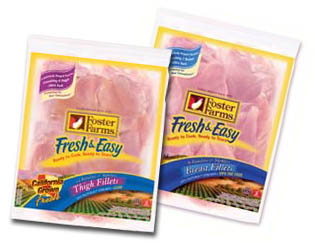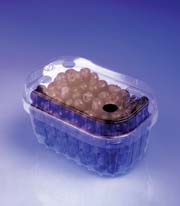
“People don’t like to touch chicken, and when they buy large portions, they don’t like to wash and wrap the parts before storing them in their freezers,” explains Gudjon Olafsson, marketing manager of new products for the $1.4 billion processor. After Fresh & Easy fillets are hand trimmed, they go through an ozonated-water rinse and then are portioned into vacuum-sealed pouches. Those pouches subsequently are sealed in an easy-tear, zippered outer bag. Half a dozen breast fillets totaling about 2.5 lbs. and a dozen thighs weighing about a kilogram are packed into each master pouch. Suggested retail prices are $4.99 and $3.99 per lb., respectively.
“Nothing has really changed in the chicken case in years, and the idea behind Fresh & Easy was to add a lot of incremental changes that produce added value and more convenience for consumers,” he adds. An unanticipated benefit of the inner vacuum pack is the retention of natural juices. Instead of evaporating in the cooler, those juices are retained and keep the fillets moist throughout the cooking process.
Special machine molds and customized roll stock had to be developed. The outer bag features preprinted film with graphics that are consistent with an overhaul of Foster Farms’ retail look. Gone are the labels that used to be inserted under plain overwrap film.
Soaker pads that can serve as swimming pools for bacteria are eliminated with the Fresh & Easy system. Relieving consumers of the nuisance of rinsing the fillets themselves should further enhance food safety by eliminating the risk of cross-contamination in the home. Although vacuum sealing should extend shelf life, Foster Farms is promoting a position of “locally grown, fresh chicken” in a convenient package, so code dates are not being extended, Olafsson says.

Sidebar: Corn-based plastic packaging wins another convert(er)
It took two years, but Cargill Dow LLC has snared its first North American package converter for NatureWorks PLA, a polyactide polymer made from the carbon in corn sugar, rather than petroleum.Wilkinson Manufacturing Co., a Fort Calhoun, Neb., converter of OPS plastic packaging and aluminum foil, has begun production of thermoformed PLA food containers for pies, deli trays and other grocery items. Noting the firm innovated 50 years ago as the first producer of TV dinner trays for Swanson, Wilkinson’s Joe Selzer says corn-based plastic “makes so much sense. Processors, retailers and consumers all benefit because the packaging material has more environmental benefits.”
Though not a good oxygen barrier, PLA offers exceptional clarity, similar to PET, according to Michael O’Brien of Cargill Dow, Minnetonka, Minn. The material’s rigidity is superior to PET, providing added protection for products that are not oxygen sensitive.
Japanese food companies were the first to embrace PLA, and the polymer’s earth-friendly positioning helped it gain European converts soon after. “Now the dam has finally cracked in North America,” O’Brien says.
IPER, an Italian hypermarket, began using the packaging a year ago, promoting it as “natural-based packaging for natural foods.” The resulting lift in loyalty and sales prompted Ilip, a Bologna, Italy, converter, to roll out PLA packaging for supermarket produce items this spring.
Production processes at Cargill Dow’s Blair, Neb., depend on fossil fuels. Still, a net savings of 20 to 50 percent is achieved compared to petroleum-based plastics, the manufacturer estimates. The Blair plant was completed a year ago and boasts capacity of 140,000 metric tons per year, 23 times greater than Cargill Dow’s original Minnesota facility, which has been mothballed. Greater capacity has helped make pricing more competitive with oil-based polymers.
For more information:
Michael O’Brien, Cargill Dow LLC, 952-984-3306, michael_o’brien@cargilldow.com. Write in 406
Joe Selzer, Wilkinson Manufacturing Co., 800-456-4519, ext. 206. Write in 407